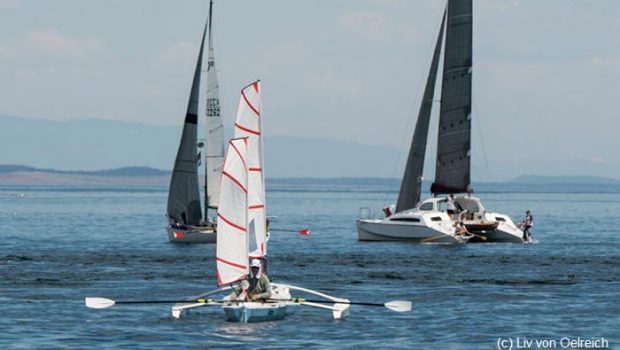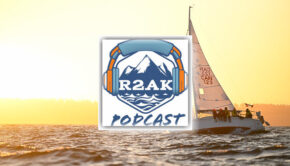Oppressive, Stagnant, and Stress Testing
Published on June 18th, 2018
Race to Alaska, now in its 4th year, began with 47 teams signing up for the adventure of a lifetime. No motor, no support, through wild frontier, navigating by sail or peddle/paddle (but at some point both) the 750 cold water miles from Port Townsend, Washington to Ketchikan, Alaska.
To save people from themselves, and possibly fulfill event insurance coverage requirements, the distance is divided into two stages. Anyone that completes the 40-mile crossing from Port Townsend to Victoria, BC can pass Go and proceed. Those that fail Stage 1 go to R2AK Jail. Their race is done.
Thirty-nine conquered the first test on June 14, of which 31 lined up on June 17 for the start of Stage 2 from the southern tip of Vancouver Island. At least that was the plan.
Before things went the slow version of sideways, the Victoria restart was like any other. The teams were ready, or not, making last-minute repairs, hugging loved ones, talking to fans who wandered down to the dock, sharing in the spirit with other crews.
Twenty minutes until go time the docks cleared, teams ascended the seawall steps to gather under the bronze glare of Captain Cook, who seemed somewhere between unimpressed and affronted by R2AK’s ragtag navy of sailors assembled at his feet.
They were there, beyond ready, and the energy came as close to carbonation as the human condition can attain; after all of the effort, preparation, waiting, repairs, waiting some more, they were all there, their bodies and nervous energy compressed into 30×30 space that felt pressurized with excitement and nervous about Mentos.
The five minute/five bell countdown gathered crowds along the Victoria’s Inner Harbour, crowds that had either traveled some distance for the explicit purpose of watching the R2AK launch, or the people who saw a crowd and wondered what the hell everyone was doing.
The ubiquitous, “They’re doing what/going where?” question was regularly followed by an open-mouthed “no way” response to the answer. When they learned there was a guy on a paddleboard, it escalated. “Have you shaken his hand? That guy has muscles in his sh#t,” was our favorite superfan explanation on why he’d be okay. Five to noon, and the spectacle is as fresh as ever.
The Victoria restart is conceptually simple: when the bell tolls high noon, run from Captain Cook to your boat, cast off and go. Since sailing is illegal in Victoria’s Inner Harbour, teams have to human power their way past the landing seaplanes and water taxi ballet (yes, this is a thing) to the point where the Queen (or whatever, for sure it’s a law) says you’re clear to raise sails—unless you’re on a paddleboard, kayak, or custom pedal-powered affair; then you’ve cast your own fate; just keep it up until Ketchikan.
After the running, after the rowing, after finding out exactly how bad their human-power options were, after that harbor full of drama, the sailing start of the race had all of the cheering throng culmination of the beginning of an Olympic event, but more like the 10k Speedwalk.
The cheering mounts, they take their marks, are set, the gun fires, and they toddle off as fast as heel toe, heel toe can carry them—it’s goofy to watch and slower than the crowds that mob the finish line to congratulate the winners.
This year, the R2AK fleet rowed/paddled/pedaled to the part of the harbor where sailing is legal, sails were raised into a state of near perfect atmospheric stillness—absolutely no wind. None, for miles and hours, and ever. The opening joke of this R2AK was the cruel one-liner: that the teams had to human power out of the harbor, just so they could keep human powering for at least the next couple of forever.
Why? A high-pressure system sat on the race like a sweaty, fat man with a broken fan—oppressive, stagnant, and stress testing the 54” Sansibelt shorts with 80-degree weather and no relief in sight.
From the time they launched, and then through the first night until the 4 am time stamp on this set of keystrokes, teams were trying to sail in as much wind as the inhale on “Happy Birthday,” and the forecast didn’t seem like it was going to blow out the candles anytime soon.
80 degrees, this would be lighting bug weather if the Midwesterners on Team Buckeye had anything to say about it. As it is, it’s just a sweaty reminder that muscle can outlast sailed progress, if only for a while. With the lack of wind and flat water, the human-powered teams were flying the “I told you so” flag as they sprinted into a lead they maintained for the first day.
When he went to bed, the pedal-powered rocket that is Team Take Me to the Volcano anchored in pole position some ten miles to the good of the first sailing-centric team, with the muscled feces of Team Torrent closing a few miles behind. The twin paddles of Team Oaracle had done a similar run ahead, as had Team TRAK Kayaks—at sunset three of the top five teams had no option to sail.
As the day wore sweatily on, teams who had planned on sailing to Alaska faced the dilemma: to row or not to row, a three-part Shakespearean riddle of light wind, high heat, and the sheer annoyance and indignity of propelling a sailboat under human power.
There is a desperate calculus to determine when to row a sailboat. In our experience, it’s the direct function of the duration on the oars, the heat of the day, how close you are to other racers, and your brain’s ability to convince itself that apparent wind is real wind.
Hitting pause on the prose for a “technical service announcement,” there are two kinds of wind: real wind and the wind you can feel. Real wind is, well, wind; air moving across the earth driven by thermal differentials and the difference between gravity’s effect on air and the speed of rotation of the big blue ball we call home. Apparent wind is the other kind: the “if you stick your head out of the car window it feels like a hurricane” kind of wind.
Dial that car window down to the 2-3 knots of speed you can muster from rowing a sailboat that wasn’t meant to row, and for most boats, for most of the time, 2-3 knots of apparent wind that you get from rowing through still air is all your oar-weary arms need to convince your brain that the wind is real and that you should really stop rowing and sail.
Here’s the thing: your brain is a liar.
You’ll raise the sail, coast to a stop, apparent wind goes to zero, and your brain takes over again and convinces your arms to hit the oars. Versions of this drama were playing out all over day one, from the becalmed frustrations that kicked off as teams nosed into Victoria’s sailing green zone, through the hot and bothersome afternoon, into the cool, still night when their saltwater reflections easily identified constellations.
Environment Canada was too proper to call it what it was: flat ass calm, and they weren’t calling for prolonged lumpy anytime soon.
At the time of this update (on June 18), the sun is rising on a freshening breeze in the southern Strait of Georgia, and after a long night of pedal drifting to set themselves into position, Team Sail Like a Girl is well poised to catch it soon. The chase pack that followed them through Boundary Pass closed the gap overnight, and as of dawn, the bulk of the R2AK’s podium hopefuls are bunched along the Gulf Islands side of the Strait of Georgia.
In a tortoise/hare analogy that doesn’t actually work—Team PT Watercraft retired from a commanding lead and set the hook when it got dark, slept for a solid eight, and pedaled out of the Gulf Islands into the Strait of Georgia still in the lead, well rested and a few miles closer to the wind than anyone else. With all of the current and calm, sleeping at anchor appears to have been the fastest solution set to last night’s calculus.
Day one had that Jesse-Owens-outruns-a-horse sort of quality; “I beat a trimaran on my paddleboard” sounds like the kind of bar bet fodder that ought to be worth a pint or two. Considering the winds to come, the human-powered set should take all the free pints they can get, because it won’t take too many millibars for the sailing fleet to close the gap.
So it’s morning, we’re 16 hours and less than a 100 miles in, and while favorites are still emerging, this is still anyone’s race. The weather is calling for oars, with a 50% chance of a code zero in the afternoon. Break out the sunblock, stay hydrated, put on your rowing pants; it looks like the shirtless, fat man is going to keep it sweaty for a while.
Footnote: Team Mknotkrazee, comprised of Duane Emnott and Chuck Emnott on a Nacra Inter 20, are the first to fold.
Race details – Tracker – Facebook – Instagram
Background:
Race to Alaska, now in its 4th year, begins with 47 teams stepping forward for the adventure of a lifetime. No motor, no support, through wild frontier. Entrants will soon learn if they have the physical endurance, saltwater know-how, and bulldog tenacity to navigate the 750 cold water miles from Port Townsend, Washington to Ketchikan, Alaska. Details.
Source: R2K







 We’ll keep your information safe.
We’ll keep your information safe.